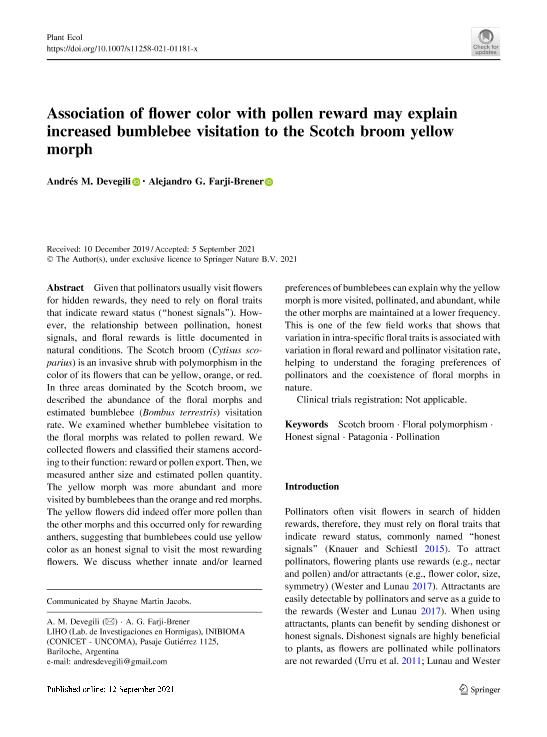Mostrar el registro sencillo del ítem
dc.contributor.author
Devegili, Andrés Matías

dc.contributor.author
Farji Brener, Alejandro Gustavo

dc.date.available
2023-01-06T09:57:16Z
dc.date.issued
2021-12
dc.identifier.citation
Devegili, Andrés Matías; Farji Brener, Alejandro Gustavo; Association of flower color with pollen reward may explain increased bumblebee visitation to the Scotch broom yellow morph; Springer; Plant Ecology; 222; 12; 12-2021; 1325-1334
dc.identifier.issn
1385-0237
dc.identifier.uri
http://hdl.handle.net/11336/183675
dc.description.abstract
Given that pollinators usually visit flowers for hidden rewards, they need to rely on floral traits that indicate reward status (“honest signals”). However, the relationship between pollination, honest signals, and floral rewards is little documented in natural conditions. The Scotch broom (Cytisus scoparius) is an invasive shrub with polymorphism in the color of its flowers that can be yellow, orange, or red. In three areas dominated by the Scotch broom, we described the abundance of the floral morphs and estimated bumblebee (Bombus terrestris) visitation rate. We examined whether bumblebee visitation to the floral morphs was related to pollen reward. We collected flowers and classified their stamens according to their function: reward or pollen export. Then, we measured anther size and estimated pollen quantity. The yellow morph was more abundant and more visited by bumblebees than the orange and red morphs. The yellow flowers did indeed offer more pollen than the other morphs and this occurred only for rewarding anthers, suggesting that bumblebees could use yellow color as an honest signal to visit the most rewarding flowers. We discuss whether innate and/or learned preferences of bumblebees can explain why the yellow morph is more visited, pollinated, and abundant, while the other morphs are maintained at a lower frequency. This is one of the few field works that shows that variation in intra-specific floral traits is associated with variation in floral reward and pollinator visitation rate, helping to understand the foraging preferences of pollinators and the coexistence of floral morphs in nature. Clinical trials registration: Not applicable.
dc.format
application/pdf
dc.language.iso
eng
dc.publisher
Springer

dc.rights
info:eu-repo/semantics/openAccess
dc.rights.uri
https://creativecommons.org/licenses/by-nc-sa/2.5/ar/
dc.subject
FLORAL POLYMORPHISM
dc.subject
HONEST SIGNAL
dc.subject
PATAGONIA
dc.subject
POLLINATION
dc.subject
SCOTCH BROOM
dc.subject.classification
Ecología

dc.subject.classification
Ciencias Biológicas

dc.subject.classification
CIENCIAS NATURALES Y EXACTAS

dc.title
Association of flower color with pollen reward may explain increased bumblebee visitation to the Scotch broom yellow morph
dc.type
info:eu-repo/semantics/article
dc.type
info:ar-repo/semantics/artículo
dc.type
info:eu-repo/semantics/publishedVersion
dc.date.updated
2022-10-06T13:10:36Z
dc.journal.volume
222
dc.journal.number
12
dc.journal.pagination
1325-1334
dc.journal.pais
Alemania

dc.description.fil
Fil: Devegili, Andrés Matías. Consejo Nacional de Investigaciones Científicas y Técnicas. Centro Científico Tecnológico Conicet - Patagonia Norte. Instituto de Investigaciones en Biodiversidad y Medioambiente. Universidad Nacional del Comahue. Centro Regional Universidad Bariloche. Instituto de Investigaciones en Biodiversidad y Medioambiente; Argentina
dc.description.fil
Fil: Farji Brener, Alejandro Gustavo. Consejo Nacional de Investigaciones Científicas y Técnicas. Centro Científico Tecnológico Conicet - Patagonia Norte. Instituto de Investigaciones en Biodiversidad y Medioambiente. Universidad Nacional del Comahue. Centro Regional Universidad Bariloche. Instituto de Investigaciones en Biodiversidad y Medioambiente; Argentina
dc.journal.title
Plant Ecology

dc.relation.alternativeid
info:eu-repo/semantics/altIdentifier/doi/http://dx.doi.org/10.1007/s11258-021-01181-x
Archivos asociados
